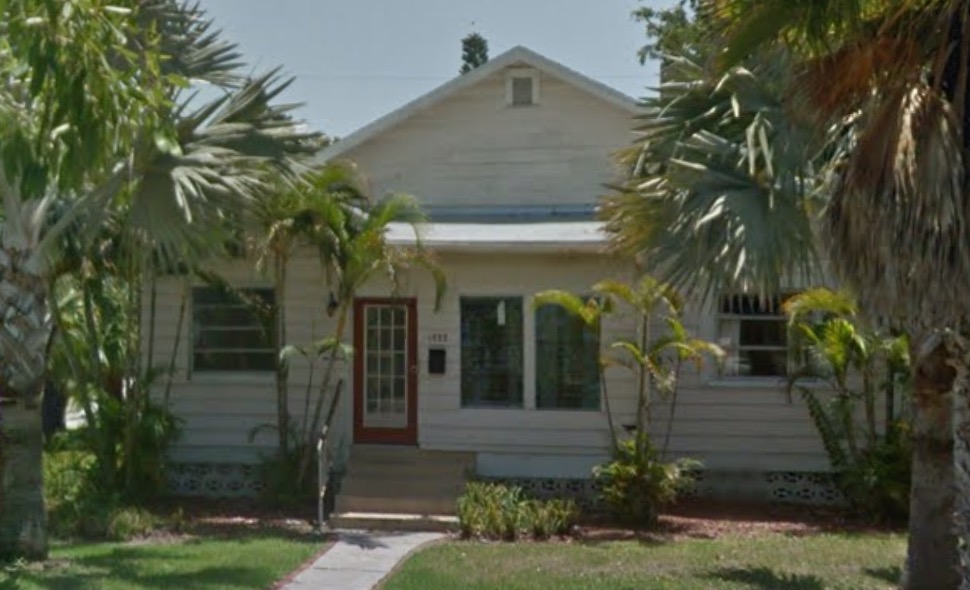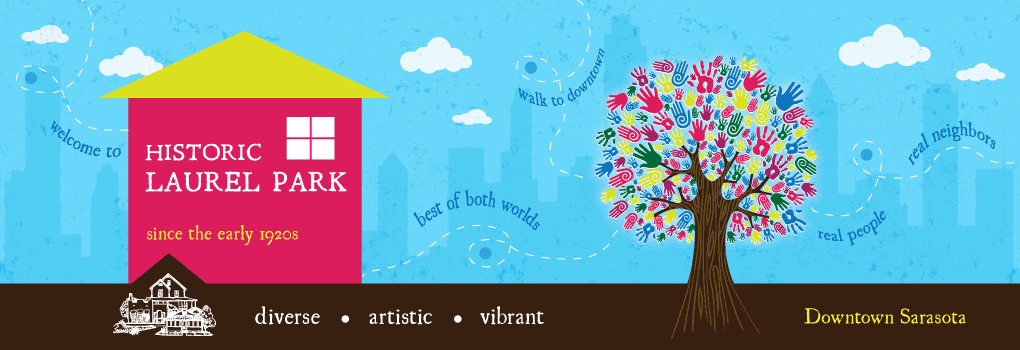1922 Oak Street / Pat Valdo

PHYSICAL DESCRIPTION
The subject structure, located at 1922 Oak Street, is a one-story, front-gabled, Craftsman-style bungalow. The front facade exhibits two gabled projections which are separated by a porch presently protected by a shed roof but originally open. The exterior fabric is clapboard and the open porch originally displayed short, square, capped, columns. Other details of the house, typical of the Craftsman Style include exposed rafter tails and a wide eave overhang. An original Board and Batten side door with a port hole window, used as a secondary entrance exists on the west elevation. With its broad roof and wide band at the base of the structure, the house has a strong horizontal feel, a trademark of the Craftsman style.
Although moved onto the site, the primary structure’s scale and setback are very much in keeping with other homes in the Morrell-Mound neighborhood and Oak Street. All of the original windows in the primary structure and most of the windows in the secondary structure have been replaced with jalousie and awning windows. Restoration plans for the primary structure call for these to be replaced with four over one, wooden, casement windows as were originally present. Transom windows originally present above the casement windows on the east elevation are also slated to be returned. The secondary structure on the site is also under consideration for historic designation. It was constructed on site around the time that the primary residence was moved onto the property in 1947. A later additon to the secondary structure was constructed on the east elevation to serve as a garage.
HISTORICAL INFORMATION
The subject structure at 1922 Oak Street was built in the early 1920’s. Originally constructed at 117 Indian Avenue, just south of Main Street, it was moved to its present location around 1947 for Pat Valdo. The structure appears on the May, 1925 & January, 1929 Sanborn Maps as well as in a 1926 panoramic phographic view of Sarasota.
Unfortunately, little is known about the structure’s earliest occupants. The 1926 City Directory does not have listings for Indian Avenue and the 1928 City Directory lists the house as being vacant. The 1930 City Directory listed Mrs. Beulah B. Dixon as the occupant.
The 1936 City Directory shows Julius J. Roth as occupant. Mr. Roth was associated with Mr. Bert Cohn of Bert Cohn Furniture company which was located on Main Street. Mr. Roth was a resident of Sarasota from 1935 until his joining the Army in 1940. He returned to Sarasota in May, 1961 and passed away at the age of 51 on September 9, 1962.
In 1936 Patrick F. Fitzgerald and his wife Laura purchased the house and property at 117 Indian Avenue from Floyd and Madeline Ziegler. Apparently the Fitzgeralds did not move in immediately, for the 1938 City Directory list R. F. Ralvado as occupant. However, by 1940 the Fitzgeralds were residing at 117 Indian Avenue.
In the early 1940’s Pat Valdo moved a house to 1922 Oak Street in the Washington Park Subdivision. Documentation is reasonably conclusive that the house was moved from Indian Avenue. A photograph of the downtown taken in 1926 shows the back of the house on Indian Avenue. Sanborn Insurance Maps for the area show a house on the downtown lot in 1929 which was gone by 1953.
The appearance of a house of similar configuration on Oak Street in the 1954 Sanborn Map corresponds with these.`events. While there are some minor differences in the outlines of the buildings shown on the maps they are similar enough to support this conclusion considering the overall accuracy of the Sanborn Insurance Maps. This physical documentation combined with the fact that the 1946 City Directory has Pat Valdo living at 1922 Oak Street provides evidence to show that the Oak Street house and the Indian Avenue house are one in the same. The subject structure is located on the corner of Lafayette Avenue and Oak Street in the Washington Park Subdivision.
YALDO, PAT (1881-1970) Pat Valdo was born Patrick Francis Fitzgerald in Binghamton, New York. Because his father, William J. Fitzgerald, owned the largest union cigar factory in the city, it was assumed that the young man would follow in the trade. As a youth, however, Pat was fascinated with show business, assisting touring repertory companies and sneaking into circuses. He learned to juggle from a traveling vaudevillian. Eventually he quit school in tenth grade to go on the road. His first professional touring was as a candy butcher with the Walter L. Main Circus. Just a few months later he signed onto the John Robinson Circus as an apprentice clown for $10 a week. Soon he had developed his trademark character as a whiteface clown, accenting the face with broad red lips and black eyebrows. It was also there that a veteran joey in Clown Alley recommended Fitzgerald change his surname to Valdo. In 1904 he was hired away by the Ringling Bros. Circus.
During the off-season, he toured the vaudeville circuit, sometimes appearing as an equestrian clown with the Orrin Davenport troupe. As a producing clown on Ringling, Valdo was a master at creating clown gags. Among his best known were the midget clown firehouse gag and his red whirling wig. In the tradition of Dan Rice, Valdo comically interacted with the equestrian director as well as with other performers. Perhaps Valdo’s most remembered gag was dressing up his pet dog as a miniature elephant. After performing several stunts, the tiny “elephant” would jump into Valdo’s pants. The gag created a sensation, and Valdo even did the bit as an actor in the Broadway play, Polly of the Circus-later made into one of the first movies with a circus theme. To this day, an elephant-dog is still a popular “clown walkaround”. Valdo moved from Ringling to the Barnum & Bailey Circus and briefly onto The Hagenbeck-Wallace Circus.
Back on the 1910 Barnum & Bailey show he met Laura Meers, who was performing with her brother as a wire walker. After marrying her in 1914, Valdo joined their act. In 1923 Valdo’s career changed direction when Charles Ringling made him an assistant to Fred Bradna, the ringmaster on the big one.
In 1929 John Ringling promoted Valdo to supervisor of performance and director of personnel, a position he fulfilled for the rest of his professional career. Three years later Valdo made his first European tour as a talent scout for new acts for the Ringling Bros. and Barnum & Bailey Circus. About his new management role of working with the cast and crew, Valdo said:
It’s one big family of children. We take care of them. I listen to their gripes, calm down their artistic outbursts, feed them, help them save their money, take care of their insurance and doctor’s bills, send their children to school. We’re a league of nations, learn each other’s language.
In 1969 Pat Valdo was made the Ringling circus’s first director emeritus. He died in Sarasota on November 7, 1970.

